Understanding the impact of temperature and humidity on fluid art materials is like mastering a magical recipe. Too much heat and your paints might dry so fast they crack, too cold and they become thick and unwieldy. Humidity is another trickster; high levels can make paint dry slower, stay tacky, and even invite the dreaded mold. Think of it as goldilocks needing the perfect balance—a cozy 21-27°C and 40-60% humidity. This guarantees your paints flow like a dream without turning into a nightmare. Stick around to get the full scoop on creating your masterpiece without weather woes!
Key Takeaways
- Warm temperatures decrease paint viscosity, aiding in smoother pouring and blending.
- High humidity extends drying times, potentially adding 24 to 48 hours to the curing process.
- Excessive heat can cause paint to dry too quickly, leading to cracks and surface imperfections.
- Low temperatures increase paint viscosity, making pouring and blending more challenging.
Understanding Fluid Art Materials
Understanding fluid art materials is vital for achieving the desired consistency and flow patterns in acrylic pour art. One of the key components is the viscosity of the paint, which needs to be just right—not too thick like traditional acrylics, yet not as thin as water. This sweet spot allows the paint to flow smoothly and interact in fascinating ways. High-quality fluid acrylics and soft body paints are essential, as they guarantee better flow and more vibrant color mixing.
When it comes to color mixing, it’s a bit like cooking—using the right ingredients in the right proportions makes all the difference. High-quality paints blend seamlessly, creating stunning shifts and patterns that are the hallmark of fluid art.
But it’s not just the paint you need to take into account. Pouring mediums help thin the paint to the perfect viscosity for pouring, and they can also enhance the colors and their interactions on the canvas.
Additionally, preparing your canvas with gesso or an acrylic primer sets the stage for your masterpiece by providing proper adhesion and stability. This prevents issues like lifting or instability in your paint layers, making the final result more professional and polished.
Role of Temperature in Fluid Art
Temperature plays an essential role in fluid art, as it directly influences the viscosity and drying properties of acrylic paints.
Imagine you’re working on a masterpiece, and suddenly, your paint behaves differently. That’s temperature effects at work! When it’s warm, acrylic paints get thinner, making them easier to pour, mix, and blend. It’s like having a magic wand for smoother, more fluid art.
But beware, if it gets too hot, your paint might dry too fast, leading to cracks and uneven surfaces—a real nightmare for any artist.
Now, think of a chilly day. If the temperature drops below 15°C, your acrylics will become thicker and more brittle. Picture trying to pour honey that’s been in the fridge—super frustrating, right? This increased viscosity can make your artwork look stiff and might even cause cracking.
For the best results, aim for a sweet spot between 21°C and 27°C. This range keeps the viscosity changes manageable and guarantees a balanced drying process.
But watch out for temperature fluctuations as they can cause surfactant migration, messing up your paint’s stability and making your beautiful piece look unintendedly weird. So, keep an eye on that thermostat!
Humidity’s Effect on Drying Times
While temperature plays a pivotal role in fluid art, humidity is another critical factor that greatly impacts drying times and the overall quality of acrylic pour paintings.
Humidity effects can be quite dramatic, often extending the drying duration considerably. Imagine waiting an extra 24 to 48 hours just for your masterpiece to finally set! This happens because the moisture in the air slows down evaporation, making your paint and glue take ages to cure. High humidity levels can make acrylic paint stay tacky for longer, which can be super frustrating. You might find yourself dealing with smudges or accidental blends if you’re not careful.
Ideally, you want the humidity to be between 40% and 60%. Any higher, and your paint might soak up too much moisture, dragging out the drying time and messing with your schedule.
Plus, high humidity can make your pouring mediums more fluid than you intended, changing how your colors flow and mix. So, if you’re planning a pour, keep an eye on the weather and maybe invest in a dehumidifier.
Adjusting your techniques and timelines to account for these humidity effects can save you a lot of headaches down the road!
Mold Risk From High Humidity
High humidity can be a real nightmare for fluid artists, as it encourages mold growth on materials like canvas and wood, which spells trouble for your beautiful creations.
Imagine this: mold can appear in just 24 to 48 hours, turning your masterpiece into a health hazard and a damaged mess.
To keep your art safe, it’s essential to control indoor humidity with dehumidifiers and good ventilation, keeping those mold spores at bay.
Humidity-Induced Mold Growth
Heightened humidity levels pose a significant risk for mold growth on fluid art materials, as moisture absorption by organic components like canvas and paint creates an ideal environment for spore proliferation.
Imagine spending hours perfecting your fluid art piece, only to find it ruined by pesky mold! It’s a nightmare for any artist. Mold can develop within just 24 to 48 hours when the relative humidity exceeds 60%, which means your masterpiece can quickly turn into a moldy mess.
To keep your artwork safe, mold prevention strategies are essential. One key step is to use humidity monitoring techniques. Keeping an eye on indoor humidity levels can help you spot trouble before it starts.
If you notice the humidity creeping up, a dehumidifier can be a lifesaver, keeping levels below 50%. Good ventilation in your workspace also helps keep moisture at bay.
Additionally, regularly cleaning and disinfecting your supplies and surfaces with isopropyl alcohol can make a big difference. This simple habit can stop mold from gaining a foothold, even in high-humidity environments.
Preventing Mold Formation
To minimize the risk of mold formation, it’s important to implement effective moisture control measures in your art studio. Mold prevention strategies are critical, especially when working with acrylics, which are notorious for attracting mold if not properly managed.
First off, keep an eye on the humidity levels in your studio. Anything above 60% can turn your creative haven into a mold playground. Using a dehumidifier to maintain a range between 40% and 50% can be a game-changer.
Acrylic care tips are essential here, too. Make sure your artwork dries completely within 24 to 72 hours; lingering moisture is a mold magnet.
Store your paints and canvases in dry, well-ventilated areas to avoid any nasty surprises. And don’t forget, once your masterpiece is fully cured, slap on a protective varnish. This acts like a superhero’s shield, keeping moisture at bay and giving mold fewer chances to crash your art party.
Humidity Control Techniques
Managing indoor humidity levels is essential for preventing mold growth and preserving the integrity of fluid art materials. Imagine this: you’ve spent hours on a stunning fluid art piece, only to discover mold creeping along the edges of your canvas. Not cool, right? High humidity is often the sneaky culprit here, creating the perfect playground for mold to thrive.
Regular dehumidifier maintenance can be a game-changer in keeping moisture levels in check. Think of your dehumidifier as your art’s best friend—it needs care to keep doing its job. Clean those filters and empty the water tank regularly to keep it running smoothly.
Let’s talk storage solutions. Keeping your art supplies in dry cabinets with good ventilation can be a lifesaver. These cabinets act like a fortress against moisture, giving mold no chance to invade your precious materials.
A little isopropyl alcohol spritz on your supplies now and then can also work wonders. It’s like giving your art area a protective shield, ensuring a clean and mold-free environment.
Challenges of Low Humidity
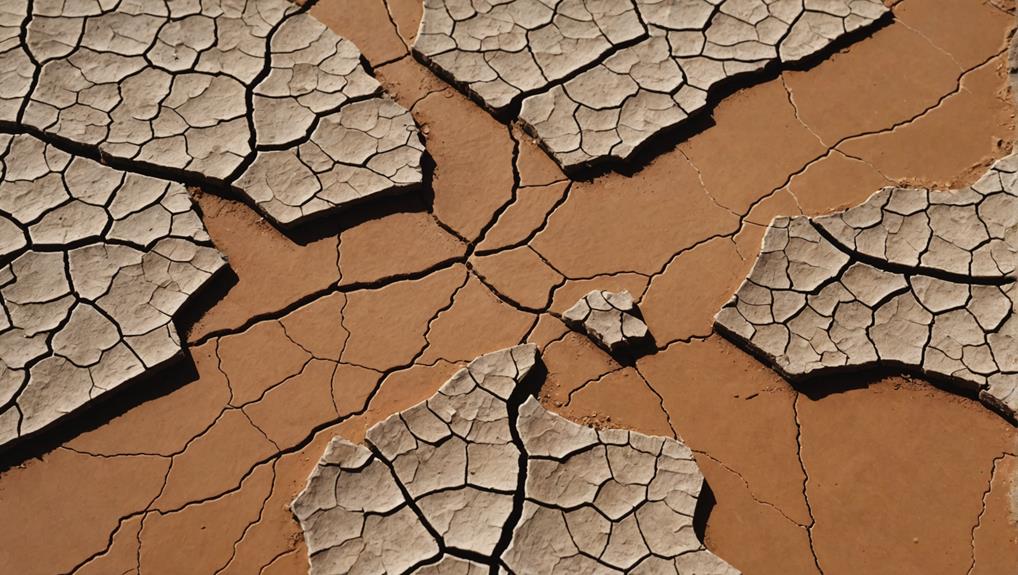
Low humidity poses significant challenges for fluid art materials, primarily by accelerating the drying process of acrylic paints. These drying challenges can lead to cracking and uneven surfaces if the paint isn’t applied quickly enough. Imagine working hard on a piece, only to see it dry too fast and ruin the smoothness you aimed for—that’s frustrating!
Another issue is paint adhesion. When the air is too dry, the paint can thin out and lose its sticking power, leading to lifting and instability in the layers. It’s like trying to stack cards on a windy day—everything just falls apart.
Additionally, without enough moisture in the air, paint can become overly viscous, making it tough to pour and spread evenly. This can be a nightmare for artists who rely on specific fluidity for their techniques.
Low humidity can also mess with the curing process, leaving your artwork with incomplete polymerization, which impacts long-term durability.
And let’s not forget the risk of dust contamination! Dry environments can lead to more dust settling on your drying work, affecting the final look.
Surfactant Behavior in Paint
Understanding how surfactants behave in paint is like watching a drama unfold on a tiny stage.
These molecules migrate to the surface while the paint dries, and their actions are influenced by temperature and humidity, which can change the whole performance.
Imagine the paint surface as a battlefield where surfactants respond to environmental conditions, impacting everything from the paint’s durability to its ability to stay clean.
This makes the behavior of surfactants a vital topic for anyone passionate about fluid art.
Surfactant Migration Patterns
Surfactant migration patterns in paint are greatly influenced by hydration and dehydration cycles, impacting both the performance and appearance of dried paint surfaces. The surfactant behavior is vital in understanding these migration pathways. When the relative humidity (RH) changes, surfactants can move within the paint, sometimes reaching the surface. This migration can cause soil attraction, making the paint look dirty over time.
Temperature changes add another layer of complexity. Surfactants can clump together or dissolve depending on how hot or cold it gets. This affects how well they work to keep the paint film intact. In acrylic emulsion paints, hydrophilic (water-attracting) components play a significant role in surfactant migration. When these components absorb moisture from the air, they can cause surfactants to move, altering the paint’s surface.
Acrylic films, known for their mechanical softness, can also make this problem worse. Soft films let surfactants migrate more freely, which can lead to more soil build-up and a less appealing look. This makes understanding surfactant migration patterns essential for maintaining the quality and longevity of fluid art materials.
Environmental Influence Mechanism
The behavior of surfactants in paint films is intricately influenced by environmental factors such as temperature and relative humidity, which affect their migration and interaction at the paint-air interface.
Imagine your favorite painting suddenly becoming sticky because the room gets humid—sounds like a nightmare, right? That’s what happens to surfactants in acrylic emulsion paints. When relative humidity (RH) goes up, these surfactants get all excited and start migrating to the surface, making the paint softer and stickier. This can attract dirt like a magnet, turning your masterpiece into a mess over time.
Now, let’s talk about when the air gets dry. Lower RH makes the paint stiff as a board because surfactant properties change—they can’t move around as much. In fact, the paint can get up to 300% stiffer.
Temperature also plays a sneaky role here. It affects how surfactants dissolve and clump together, which in turn impacts the paint’s durability and overall feel.
For art conservators, understanding these environmental interactions is like having a secret weapon. Knowing how surfactants behave under different conditions helps them protect and preserve artworks, ensuring they stay beautiful for years to come.
Mechanical Softness and Soil Accumulation
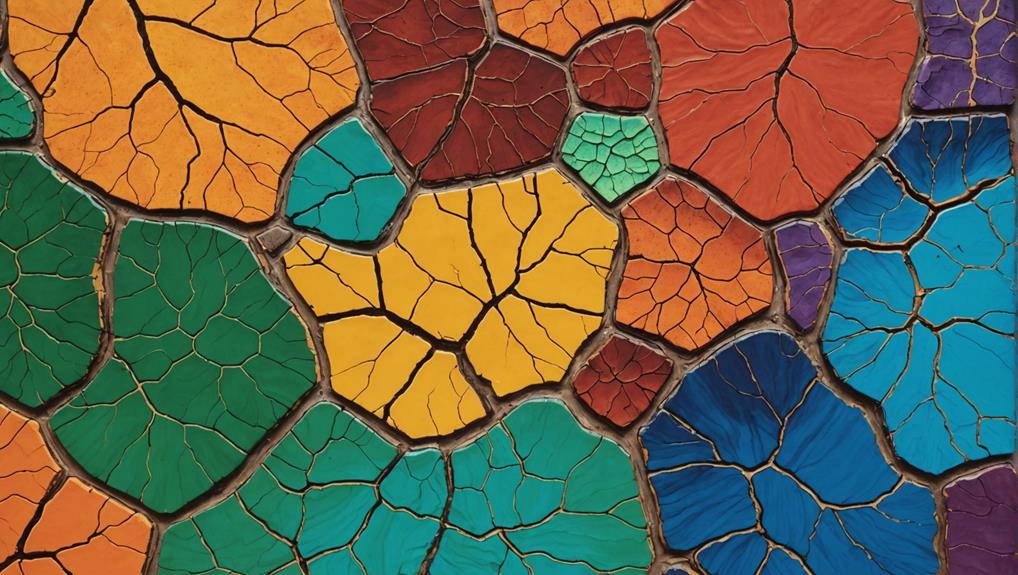
Acrylic paint films exhibit a pronounced mechanical softness that facilitates the accumulation of soil and pollutants over time.
Imagine carefully crafting a beautiful piece of fluid art, only to see it gathering dust and grime because the paint is too soft. That’s right—mechanical softness means the paint can get squishy with changes in humidity, making it a magnet for dirt.
When the weather gets humid, acrylic paint becomes even softer, and dirt just loves to stick to it. It’s like how wet sand clings to your feet at the beach.
Surfactants, those sneaky little chemicals in the paint, move around with hydration and dehydration cycles. They change the paint’s surface and make it more likely to attract soil.
And it’s not just any dirt—those hydrophilic components in the paint love water, so they attract all kinds of grime, especially if the temperature and humidity keep changing. It’s like the paint has a built-in dirt-magnet.
Analytical Techniques in Fluid Art
Understanding how temperature and humidity affect fluid art materials requires some pretty cool scientific tools.
Imagine using a super-powered microscope to see every tiny bump and ripple on your painting’s surface or special sensors to feel how your paint changes when it’s hot or damp.
These techniques give us amazing insights into how our materials behave, helping artists create more stable and vibrant works of art.
Surface Analysis Methods
Exploring advanced surface analysis methods is vital for grasping the intricate effects that temperature and humidity have on fluid art materials. Texture analysis becomes critical as subtle changes in the paint film can considerably alter the artwork’s feel and appearance. Three-dimensional microscopy excels in this area, offering a detailed view of the physical transformations that occur under varying environmental conditions.
Color consistency is equally important, and techniques like attenuated total reflectance Fourier transform infrared microscopy allow us to see how chemical shifts impact the artwork’s hues over time. By examining these changes, artists can better predict and control the visual outcomes of their creations.
Here’s a closer look at some key methods:
| Surface Analysis Method | Key Insights Provided |
|---|---|
| Three-dimensional microscopy | Detailed texture changes |
| Quartz crystal microbalance (QCM) | Mechanical properties |
| Desorption electrospray ionization-mass spectrometry | Surfactant migration |
| Attenuated total reflectance Fourier transform infrared microscopy | Chemical composition changes |
| Environmental scanning electron microscopy (ESEM) | Surface and moisture interactions |
These methods collectively offer a thorough toolkit for artists and conservators, enabling them to navigate the complex interplay between environmental factors and fluid art materials. Understanding these dynamics guarantees that the vibrant, dynamic nature of fluid art is preserved and enhanced.
Material Behavior Insights
In fluid art, analytical techniques such as three-dimensional microscopy and quartz crystal microbalance (QCM) are essential for elucidating the material behavior under varying environmental conditions.
Imagine using a super-detailed microscope to see how paint changes when it’s hot or cold, or when the air is really humid. Three-dimensional microscopy lets us do just that! It allows us to observe how the physical structure of paint morphs, affecting everything from color mixing to the way the paint flows.
Now, think about QCM as a fancy scale that measures super tiny weight changes in the paint as it dries. This tool helps us understand viscosity changes, which is a fancy way of saying how thick or thin the paint gets over time. It’s like watching how honey flows slower when it’s cold and faster when it’s warm. Pretty cool, right?
And don’t even get me started on how humidity can mess with things! That’s where desorption electrospray ionization-mass spectrometry (DESI-MS) and attenuated total reflectance Fourier transform infrared (ATR-FTIR) microscopy come in. These tools dive deep into the chemical behavior of paints, showing us how surfactants (like the soap in paint) move around and how the paint’s chemistry changes with the weather.
Conservation and Preservation Strategies
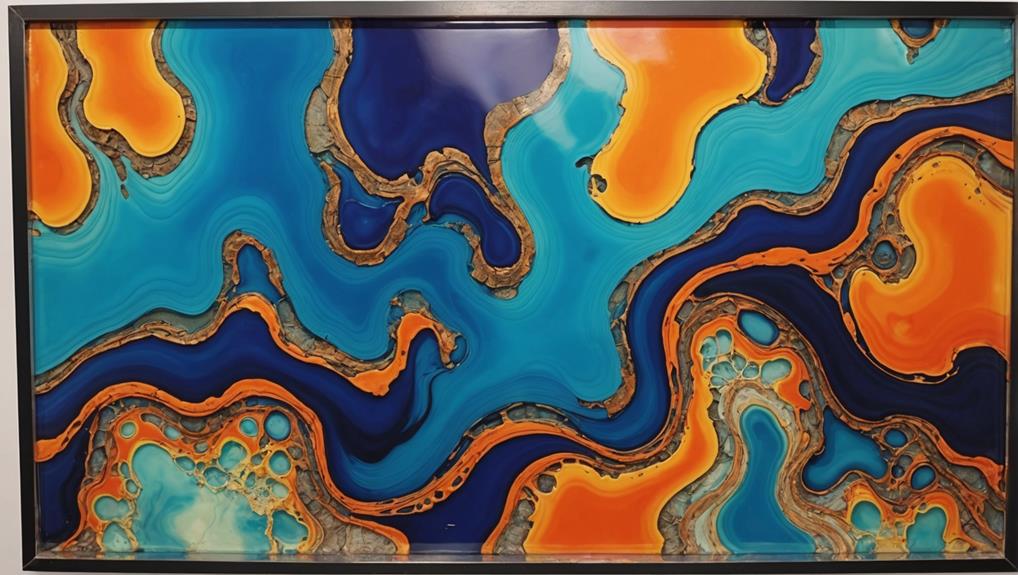
Maintaining stable environmental conditions is essential for the conservation and preservation of fluid art materials. Fluctuations in temperature and humidity can wreak havoc on these delicate artworks, causing cracking and degradation of acrylic paints. To combat this, implementing effective conservation techniques and preservation methods is important.
Firstly, keeping the temperature between 18-22°C (64-72°F) and relative humidity (RH) between 45-55% helps secure the stability of the paint films. Regular monitoring of these conditions in storage and display areas is critical, as it prevents moisture buildup, which can lead to mold growth and warping of materials.
Moreover, using high-quality acrylic pour mediums that are designed for moisture resistance can greatly enhance the longevity of fluid art. These specialized mediums mitigate the effects of humidity, preserving the integrity of the paint. Protective coatings, such as varnishes specifically formulated for acrylics, act as barriers against environmental factors, extending the life of the artwork.
Lastly, proper drying techniques are important. Allowing paintings to dry in a controlled environment, free from dust and direct sunlight, helps to minimize surface imperfections and secures a smooth, flawless finish. This thorough approach ensures fluid art remains vibrant and intact for years to come.
Environmental Control in Studios
Creating an ideal environment in the studio is essential for ensuring the quality and longevity of fluid art materials. To achieve this, you need to focus on both studio ventilation and moisture management. Stable temperature and humidity levels are key to preventing issues like brittle acrylic paint or cracking.
To help you create the perfect studio environment, consider these important steps:
- Maintain a stable temperature: Keep your studio around 23°C. This helps prevent your paint from becoming too brittle or drying too quickly.
- Manage humidity levels: Aim for a relative humidity of around 50%. Using dehumidifiers can be a lifesaver, as they help control excessive moisture that might lead to slow drying times or even mold growth.
- Monitor conditions: Regularly check the environment with hygrometers and thermometers. This allows you to make necessary adjustments and keep your materials in top shape.
- Ensure good ventilation: Proper studio ventilation not only speeds up drying times but also reduces the risk of mold forming on your artwork surfaces.
Transportation and Storage of Artwork
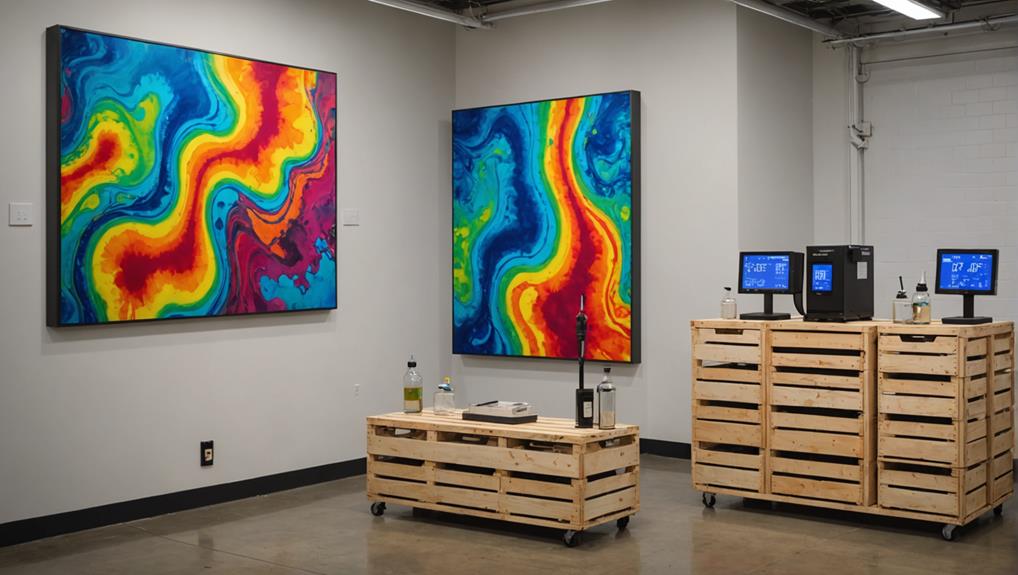
Proper handling of fluid art materials extends beyond the studio, necessitating meticulous attention during transportation and storage to preserve the integrity and longevity of the artwork.
Transport logistics play an essential role in this process. High temperatures can make fluid art overly soft or runny, leading to unwanted color mixing or damage. Consequently, keeping the artwork in a temperature-controlled environment during transit is imperative.
Humidity fluctuations can be equally problematic, as moisture absorption by the canvas can cause warping and structural instability. To counter this, pieces should be stored in environments with stable temperatures below 77°F and relative humidity levels between 40% and 60%. Proper ventilation is also important to prevent mold and mildew, which can damage the artwork.
When it comes to physical handling, transporting fluid art pieces upright and cushioned in padded cases helps prevent impact damage and paint layer disturbances. Additionally, securing artwork insurance is wise to mitigate financial risks associated with potential damages during transport.
Frequently Asked Questions
How Does Humidity Affect Artwork?
Humidity affects artwork by extending drying times and compromising the integrity of materials. Effective moisture control is essential to prevent mold growth, guarantee proper paint adhesion, and achieve smooth varnish finishes, safeguarding the artwork’s longevity.
How Do Temperature and Relative Humidity Affect Archival Materials?
Temperature and relative humidity greatly affect archival materials by compromising archival integrity and accelerating material degradation. Fluctuations can lead to brittleness, deformation, and chemical damage, underscoring the need for controlled environmental conditions to guarantee preservation.
How Does Humidity Affect Painting?
Humidity levels greatly affect painting by causing moisture absorption in the canvas, leading to shrinkage and swelling. This results in stress on paint layers, potentially causing cracking, lifting, and compromising the artwork’s structural integrity.
What Is the Effect of Temperature and Humidity?
Temperature fluctuations and varying humidity levels can greatly impact the integrity of art materials, causing issues such as brittleness, softening, deformation, and cracking. Stable environmental conditions are essential for preserving the quality and longevity of artworks.
Conclusion
Temperature and humidity greatly influence fluid art materials, affecting drying times, mold formation, and the overall integrity of artworks.
High humidity can lead to mold growth, while low humidity poses challenges such as cracking.
Appropriate environmental control, analytical techniques, and proper conservation strategies are vital for the preservation and transportation of fluid art.
Awareness and management of these factors guarantee the longevity and quality of fluid artworks, safeguarding artists’ creative expressions for future appreciation.

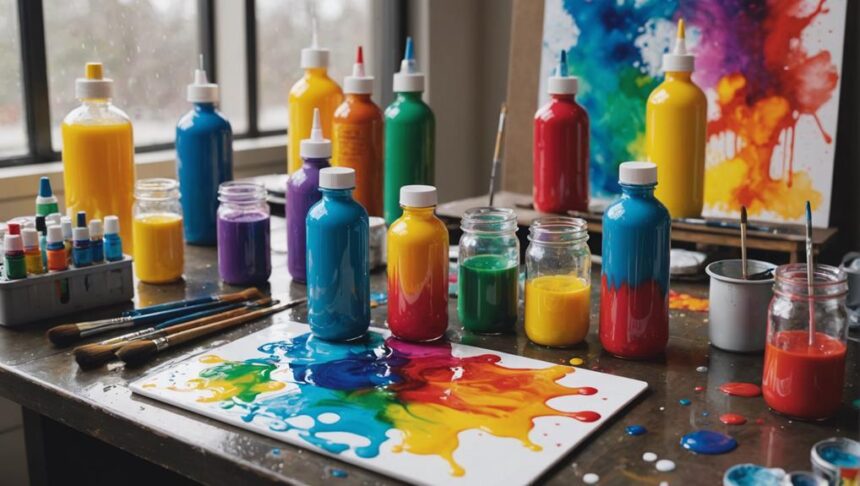
Leave a Reply